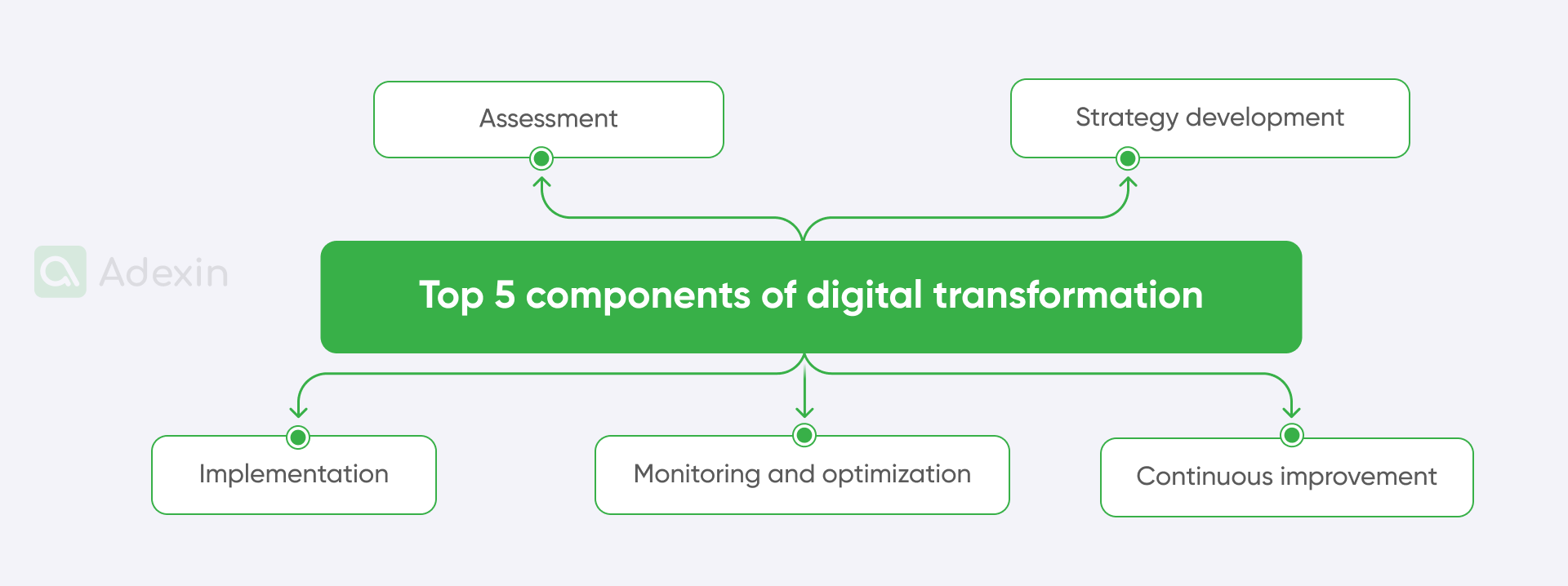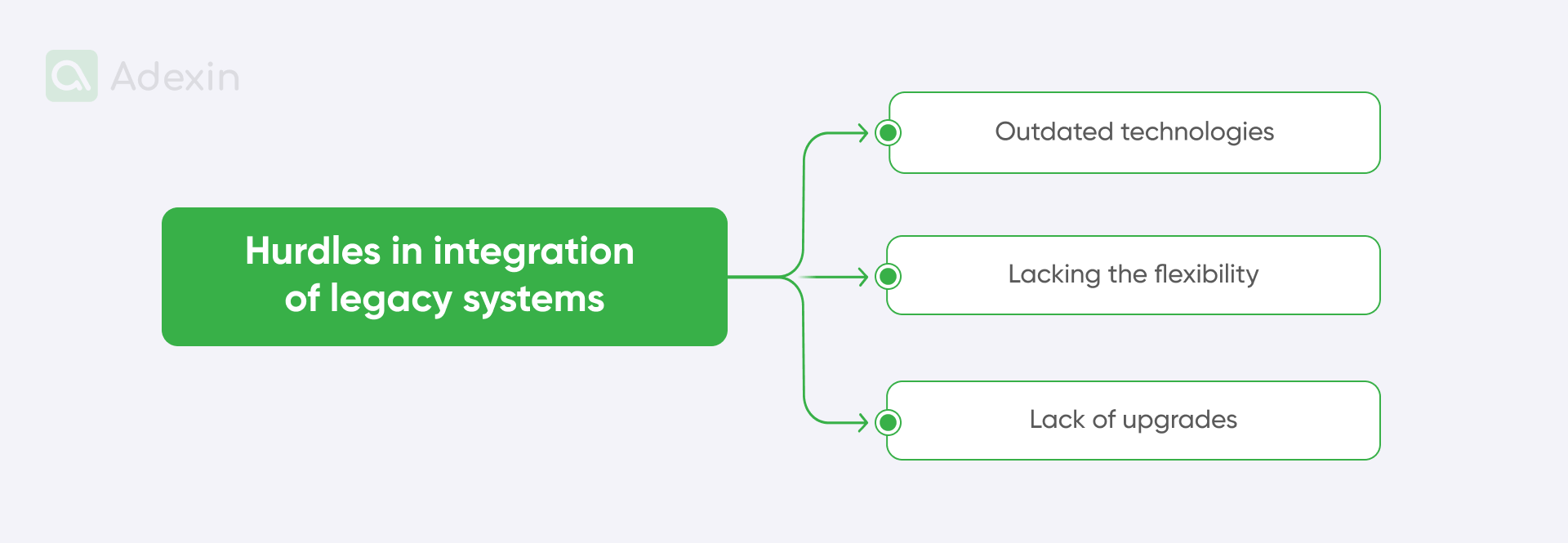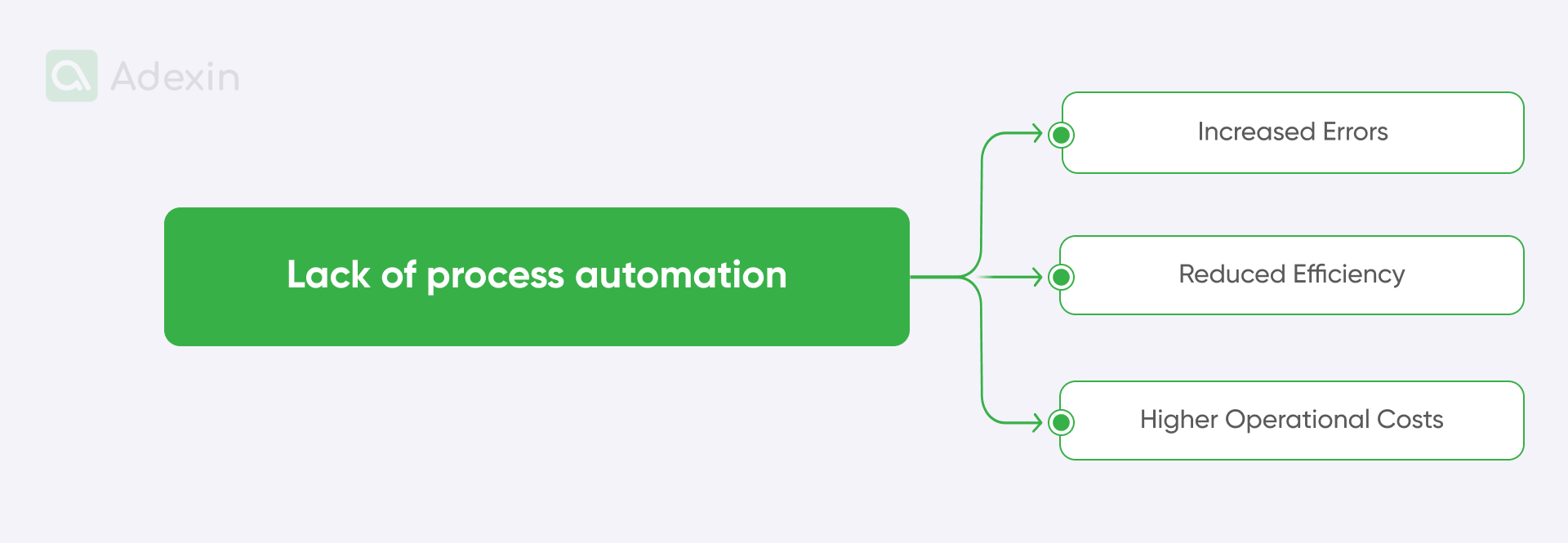Supply chain management digital transformation is about adapting modern management tailored to technology in its broadest sense. This blog will reveal matters of the digital supply chain management process and aspects related to digital transformation's benefits.
We have prepared explanations of real-world examples of successful implementation of digital solutions in the supply chain. You will have the opportunity to learn from companies that have already succeeded. Considering current global economic events, we will discuss future trends in the supply chain area.
Last but not least, we will also provide practical advice on the starting point of digital transformations. We rely on our long experience cooperating with companies and helping them navigate the digital era. It is an area from which you can also broadly benefit, as we bring over a decade of experience working with companies that are experiencing rapid revenue growth on the mass scale and scaling up quickly, all thanks to a well-prepared digital journey.
If you want to leverage digital technologies to enhance your supply chain operations, this article is definitely for you.
The concept of digital supply chains
Integrating digital technologies into all facets of supply chain operations is a fundamental shift in the supply chain. This concept is about more than just digitizing current processes. The supply chain must be reimagined and reinvented to use digital technology's power. Data is at the heart of the supply chain's digital revolution. It involves using data to obtain insights, guide decisions, and boost operational effectiveness. It can include anything from adopting IoT devices to track inventories in real time to utilizing AI and machine learning to automate repetitive processes. It can also involve utilizing advanced analytics to estimate demand more precisely.
5 steps of the digital transformation process in the supply chain

Digital supply chain management involves a series of steps requiring careful planning and execution. It's not just about implementing new technologies but also changing how the organization operates and thinks.
Here are the critical steps involved in this process:
1. Assessment. The first step in the digital transformation process is to assess the current state of the digital transformation of the supply chain. It involves understanding the existing processes, technologies, and capabilities and identifying the gaps and areas for Improvement. This step also involves understanding the business objectives and aligning the digital transformation strategy with these objectives.
2. Strategy development. Once the assessment is complete, developing a supply chain strategy is next. It involves defining the vision and objectives of the transformation, identifying the key technologies to be implemented, and outlining the roadmap for the transformation. The supply chain planning and strategy should also include a plan for managing change and ensuring buy-in from all stakeholders.

3. Implementation. The implementation phase involves deploying the identified technologies and transforming the existing processes. It could involve implementing a new supply chain digital transformation, integrating IoT devices for real-time tracking, or leveraging AI and machine learning for predictive analytics. This step also involves training the staff on the new technologies and processes.
4. Monitoring and optimization. Once the new technologies and processes are in place, it's important to monitor their performance and make necessary adjustments. It could involve tracking key performance indicators (KPIs), conducting regular audits, and continuously optimizing the processes for better efficiency and effectiveness.
5. Continuous improvement. Changes in supply chains are not a one-time project but a continuous journey. It's important to stay updated with the latest technologies and trends and continuously improve the supply chain processes to stay competitive.
Key resistances to implementing digital transformation in the supply chain
Implementing digital transformation in the logistics and supply chain can come with several challenges. These could include resistance to change, lack of digital skills, data privacy and security concerns, and high costs of implementation. Here you should pay attention to the Research on the Influence of Supply Chain Finance on Enterprise Operation Performance Under the Background of Digital Transformation.
So, let's look at what resistances are most often encountered:
Overcoming resistance to change
Change can be unsettling for many people, and employees who are comfortable with the existing processes may resist it. This can be overcome by communicating the benefits of the transformation, providing adequate training, and involving the employees in the transformation process.
Addressing skill gaps
Digital transformation often requires new skills that the existing staff may not possess. It can be addressed by providing training and development opportunities, hiring new staff with the required skills, or partnering with technology providers who can provide the necessary expertise.
Ensuring data privacy and security
With digital transformation, the amount of data collected and processed often increases, raising concerns about data privacy and security. For example, data authorization access is quite important in this context. When you're using paperwork in your warehouse management and exchanging it with carriers, you may need a document management system (DMS). The DMS can use single authentication for each user who wants to access documents, so not everyone who was previously handling shipping documents will be able to see their content. It is crucial, especially with high-value cargo, to protect your customers against theft.
Managing Costs
Implementing new technologies can be expensive. However, the cost can be justified by the long-term benefits of increased efficiency, improved customer service, and competitive advantage.
The best way to assess if you can get ROI is to map out all your operations to determine where they actually bring value by digital transformation value chain creation. In most cases, there are tangible and intangible values, but in one way or another, they can be measured based on financial outcomes.
When we implemented a mobile app for truckers, the first step was to satisfy a reasonable management assessment. In the second tier, we truly helped truck drivers in their daily work, but it wasn't measured in any way. We heard that they were satisfied, but you can also put more emphasis on this and see what the intangible ROI is.
Need help with custom mobile app development?
Learn how we can boost your logistic business processes
Explore moreSupply chain dynamics and adaptation
Navigating the dynamics of digital technology is a current trend, reshaping the landscape of global management and performance. As we navigate the digital era, companies increasingly recognize the importance of leveraging technology to streamline their supply chain operations. Currently, companies have embarked on a journey to compete in this area.
Undoubtedly, companies that become early adopters are in a far better position than their competitors. The first to adopt technology has a significant advantage in any competitive landscape. Some technologies are fully compatible even in the very early stages, so it is much better to get on that train before anyone else.
This is why companies have started to adapt so rapidly to newly acquired technologies from technology startups. In many cases, green tech startups outline the roadmap for sustainable logistics. A good example in this case is MAERSK.
MAERSK contends that AI-powered startups are leading the charge in optimizing supply chains, and according to Pitchbook, startups have attracted USD 50.5bn since 2018, accounting for 33% of total supply chain tech venture funding, USD 152bn.
These results are fairly high compared to the past several years. Thus, this shows that transformation is not merely a buzzword; for many companies now, it's a strategic imperative that can drive efficiency, enhance transparency, and foster innovation in a rapidly evolving marketplace.

What are supply chain challenges?
However, moving on a digital transformation journey has its challenges. Companies often need help with resistance to change, data security concerns, and the need for significant upfront investment.
Based on our experience, we already know what challenges companies can face while adopting new solutions. We have already handled many projects where we introduced new business approaches to companies according to their expectations.
A good example of such a project was participation in the development of a shipping document management platform. In this project, we took into account all the customer requirements, and our team was involved in the development of custom software for the document management system for eTEU. eTEU is a digital platform that makes it easy to create, edit, and share documents through an easy-to-use management system.
As with any project, including this one, there were many challenges. Considering challenges from this project and others we have successfully overcome, we outline several major obstacles while moving in digital transformation in the supply chain.
It is important to note that here, we have focused highly on the context of the software that facilitates business operations capabilities. No matter what hardware, robotics, or automation technology is deployed, the software always stands in the shadow, paying attention to deliver certain capabilities we tell you about in this article.

Here, we outlined several challenges:
Siloed operations in supply chains
The lack of integrated supply chain technology between a company's systems and processes is a significant obstacle for companies that want to start digitizing. So, every company needs to address this in advance. Siloed operations hinder effective communication and collaboration between departments, leading to inefficiencies and chaotic processes.
For example, warehouse management operations should be integrated with shipping in the context of loading capabilities. Previously, companies could only recognize a fraction of the information carriers had handed to distribution centers. It was like telling warehouse personnel something like, "Okay, we have space for one euro pallet on the trailer." Still, the lack of communication between truck drivers, the control tower, and its carrier transit planner showed that the trailer was complete when the truck arrived.
This is only a very small example of how businesses faced problems with communication but could not also measure everything without asking anybody. A better solution is for anyone to see that there is still room for an extra pallet in the truck instead of just assuming it may be possible. Overcome supply chain challenges while embarking on the digital transformation journey can increase supply chain visibility
Integration of legacy systems
Organizations often need help with the complexity of integrating new digital technologies with existing legacy systems. This clash between old and new can hinder a smooth digital transformation. Older systems, often built on outdated technologies, can be rigid, lacking the flexibility needed to adapt to the demands of modern digital solutions.

Industries very often integrate legacy systems running on the SAP ERP system that has yet to be upgraded for the last five years or more. In that case, you'll already face some obstacles, but the thing is, typical SAP doesn't have the capabilities for transport management you would like to have. So, you try to integrate your custom software with it, but it is impossible to fetch data from ERP due to its outdated protocols. Yeah, so this is how SAP can crash your business. You most likely won't be able to benefit from custom software for transportation unless you have hired skilled custom software developers who can handle mass customization and understand how ERP works.
Lack of process automation
Without automated processes, companies have difficulty streamlining operations and taking full advantage of digitization's benefits. Manual processes are prone to errors, delays, and inefficiencies, making it difficult to be productive, respond efficiently to market demands, and manage market segmentation.

For example, companies that have adapted autonomous vehicles can minimize manual input in digital transformation projects. While working in the warehouse at the receiving station, which may still require people to book newly arrived stock with barcode scanners, autonomous vehicles can take care of the putaway process. This can save a lot of time but also minimize the need for people to travel in halls between shelves in the warehouse. This is where hundreds of injuries happen, as there is little space for moving around.
Data management and security
Proper data management and security measures are critical to a successful digital transformation. Data breaches, cyber-attacks, and privacy violations can damage reputations, incur legal consequences, and undermine customer trust. Organizations must invest in robust cybersecurity measures and establish a comprehensive data governance framework to mitigate these risks.

Advances in data management should include certain elements.
For example, data authorization access is quite essential in this context. When you're using paperwork in your warehouse and exchanging it with carriers, you may need a document management system (DMS), and there is no need for any mass customization of your internal systems. The DMS can use single authentication for each user who wants to access documents, so not everyone who was previously handling shipping documents will be able to see their content. It is crucial, especially with high-value cargo, to protect your customers against theft.
"Leading the logistics industry into a climate-neutral future is a Herculean task to which we have given top priority as the Group's management team. In addition to long-term decarbonization goals, what counts most is what we can do in the here and now – in a pragmatic and goal-oriented manner." (…) -
Dr. Tobias Meyer, CEO of DHL Group
By embracing this trend, companies can unlock new opportunities for growth on a mass scale and innovation while also building a more sustainable and resilient supply chain for the future. As we move forward, it will be exciting to see how this transformation continues to evolve and shape the future of supply chain management.
The role of supply chain digital transformation
Supply chain digital transformation and its management are multifaceted. One of the key roles is to enhance visibility across the supply chain. With digital supply chain technologies, businesses can track and trace products in real-time, from the raw materials stage to the end consumer. This increased visibility can help businesses respond more swiftly, adapt to demand fluctuations, reduce stockouts and overstocks, and improve customer service.

It is crucial to understand the impact of digital transformation and its most important role for supply chain leaders is to improve efficiency. Businesses can free up their staff to concentrate on more strategic, value-added activities by automating routine tasks. Moreover, digital technologies can streamline processes, reduce errors, and increase productivity.
In supply chain management, digital transformation has significant advantages. For starters, it might result in cost savings. Businesses can cut their operating expenses by increasing efficiency and minimizing waste. Additionally, digital transformation can enhance customer satisfaction. With better visibility and control over the supply chain, businesses can deliver products faster, more reliably, and more accurately. Furthermore, supply chain leaders need to foster innovation. By leveraging technologies like AI, machine learning, and blockchain, businesses can develop new business models, create new products and services, and find new ways to deliver value to their customers.
You can gain many benefits from digital transformation but first of all is important to understand its role. According to recent research titled Digital transformation: fresh insights to implement green supply chain management, eco-technological innovation, and collaborative capability in the manufacturing sector of an emerging economy", digital transformation plays a crucial role in implementing green supply chain management and eco-technological innovation. It highlights the potential of digital transformation to enhance environmental sustainability and competitiveness in the manufacturing sector.

Role of custom software in innovation and transformation
In this context, supply chain software development plays a crucial role. These processes involve creating customized digital solutions designed to optimize various aspects of the supply chain, from procurement and inventory management to logistics and customer service. The goal is to create a fully integrated, end-to-end system that is more efficient and responsive to variations in supply and demand.
Working with a supply chain software development company can provide businesses with the expertise and resources they need to implement these digital solutions successfully. These companies specialize in developing software applications that leverage technologies such as artificial intelligence (AI), enhanced cloud computing, and blockchain supply chain operations.
Examples of digital supply chain transformation
Digital Supply Chain Transformation is a pivotal aspect of modern business operations. By leveraging digital technologies, companies can streamline their supply chain processes, improve efficiency, and enhance individual customer satisfaction. Here are a few real-world examples of an individualized approach from companies that have successfully implemented digital transformation in their supply chain.

Amazon
Amazon is a prime example of a company revolutionizing its supply chain. The e-commerce giant has implemented advanced digital tools based on customized marketing technologies such as artificial intelligence (AI), machine learning (ML), and robotics to automate its warehouse operations. It has resulted in increased efficiency, reduced human error, and faster delivery times. Amazon's supply chain is also highly responsive and adaptable, allowing it to quickly adjust to changes in demand. For instance, during the COVID-19 pandemic, Amazon was able to rapidly scale up its operations to meet the surge in online shopping.
Unilever
Unilever, a global consumer goods company, has transformed its operations to create a more sustainable and efficient supply chain. The company has implemented a digital twin technology, which creates a virtual replica of its supply chain. This allows Unilever to simulate and analyze different scenarios, enabling it to make more informed decisions and reduce waste. Unilever has reported that this technology has helped it to reduce its carbon footprint and improve its overall supply chain efficiency.
Walmart
One of the world's largest retailers has leveraged digital transformation to enhance its inventory management by integrating it with customized marketing tools. Their individualized approach supported a real-time inventory system that uses IoT sensors and AI to track inventory levels and predict demand. It has enabled Walmart to reduce overstocking and understocking, leading to significant cost savings. Walmart has also used digital transformation to improve its logistics, using autonomous vehicles and drones for delivery.
These examples demonstrate the transformative power of digital technologies in the supply chain. By embracing digital transformation, companies can not only improve their operational efficiency but also gain a competitive edge in the market and tackle better market segmentation.
Companies need to invest in upskilling their workforce, redesigning their processes to leverage digital technologies, and implementing the right technologies to deliver tangible business benefits. A recent study titled Research on Digital Transformation of Supply Chain Finance provides an interesting perspective on the supply chain digital transformation.
We don't necessarily need to provide examples; everything should be clear. If you have personnel working on inbound tasks who aren't particularly computer-savvy, their work can become error-prone over time. So, don't expect that digital solutions and mobile applications alone will help you avoid complete errors. You need people who can adapt. Similarly, regarding skills, even if your personnel aren't computer-savvy, they should be willing to upskill their work capabilities to use mobile apps, etc.
The future of digital transformation in the supply chain
The future of digital supply chain management is a topic of great interest and importance. As we move further into the digital age, the supply chain industry is poised to undergo significant changes driven by advancements in technology and shifts in consumer behavior.

One of the key trends in this area is the increasing use of artificial intelligence (AI) and machine learning (ML). These technologies are being used to improve efficiency, reduce costs, and enhance decision-making processes. For instance, AI in the supply chain can predict demand patterns, optimize inventory levels, and identify potential supply chain digital transformation disruptions before they occur. Machine learning, on the other hand, can analyze large amounts of data and identify patterns that humans might miss. It can lead to more accurate forecasting and better decision-making.
Another major trend is the rise of blockchain technology. Blockchain can provide a secure, transparent, and immutable record of all transactions in the supply chain digital transformation, from the raw materials to the final product. It can help to reduce fraud, improve traceability, and enhance accountability. Moreover, blockchain can also facilitate smart contracts, which can automate certain processes and reduce the need for intermediaries.
The Internet of Things (IoT) is another technology set to transform the supply chain industry. IoT devices can collect and transmit data in real-time, providing valuable insights into the status of goods, the condition of equipment, and the efficiency of processes. This can help improve operational efficiency, reduce waste, and enhance customer satisfaction. These trends are expected to have a profound impact on businesses and the industry as a whole.
Companies that can adapt to these changes and leverage these technologies effectively will likely gain a competitive advantage. They will be able to operate more efficiently, make better decisions, and provide more service to their customers. However, these changes also pose challenges. Companies will need to invest in new technologies, train their staff, and adapt their processes. They will also need to navigate regulatory issues, manage cybersecurity risks, and deal with the cultural changes that come with digital transformation.
A recent research paper titled Digital Transformation and Supply Chain Relationship-Based Transactions discusses the impact and mechanism of corporate digital transformation on supply chain relationship transactions. It provides insights into how digital transformation can alleviate information asymmetry and agency costs, thereby reducing the degree of supply chain relational transactions.
Are you in search of a reliable tech partner?
Adexin can help with advanced logistics solutions
Contact usFinal takeaway
The blog post has provided a comprehensive exploration of the importance and benefits of digital supply chain management processes. The key points discussed revolve around the necessity of embracing digital technologies to enhance efficiency, improve accuracy, and foster innovation in supply chain operations.
We encourage all readers to embrace digital transformation in their supply chain processes. It may seem daunting at first, but the benefits are well worth the effort. Remember, the journey of digital transformation is not a sprint but a marathon. There are no just short-term results. Do get to know more, get in touch with us, and let's talk about transforming your business together.


